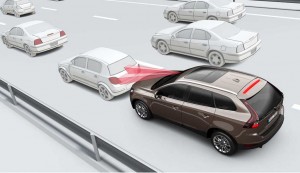
Volvo's City Safety can bring a car to a complete halt to avoid an accident. A variation may be able to spot animals on the road and avoid collisions.
It’s an unpleasant reality on the highway, but the folks at Volvo think they may have a way to cut back on the seemingly ever-present road kill using some of the same high-tech systems that the maker is using to curb inadvertent pedestrian collisions on city streets.
The new animal-friendly system is one way the now Chinese-owned Volvo hopes to build on its traditional reputation as an automotive safety leader.
Volvo has already won kudos for its latest active safety technologies, such as City Safety, which uses an infrared laser sensor attached to the windshield to monitor traffic in front of a vehicle. At speeds ranging from 2 to 19 mph – typical on crowded urban and in rush hour traffic – the system will detect a potential collision. If the driver doesn’t react by the time the two cars are 18 feet apart, it will automatically jam on the brakes.
Another version of the system can detect pedestrians and can take steps to avoid an impact. Such collisions make up a significant share of the roughly 35,000 Americans killed in roadway accidents each year.
Volvo engineers then began wondering about animals, who are killed in substantially larger numbers as the result of vehicle impacts each year. And groups like PETA, People for the Ethical Treatment of Animals, aren’t the only ones bothered by that toll.
According to a study by State Farm, there were 1.09 million deer hit by motor vehicles in the U.S. during the 12 month period ending June 30, those incidents causing $3.5 billion in damage. And such collisions routinely result in a number of deaths and injuries. Such incidents can be even more perilous in a place like Sweden, Volvo’s home, when the collision involves a moose.
The maker is looking to introduce a modified version of City Safety that might use cameras or other systems to expand its capabilities, and the new concept could show up in a couple years on the maker’s SUV models, such as the XC90, notes a Bloomberg report.
How well it will work remains to be seen. It’s hard to predict animal behavior, especially when they might suddenly emerge from hiding in a stand of trees along the roadside. But a recent study of insurance claims by the Highway Loss Data Institute found that Volvo’s City Safe system, in particular, reduced the number of vehicle damage claims resulting from car-to-car collisions by 27%, while insurance claims related to bodily injuries dropped by 51% on vehicles using the technology.
“This is our first real-world look at an advanced crash avoidance technology, and the findings are encouraging,” said Adrian Lund, president of the Highway Loss Data Institute.
Various forms of camera, radar and/or laser collision avoidance systems have been making their way to market and such insurance industry kudos – especially if paired with rate reductions – could encourage even more.
General Motors just announced a new low-cost system using a single camera. (Click Here for more.)
But Volvo appears to be the first maker specifically aiming to use such technology to be kind to animals.
